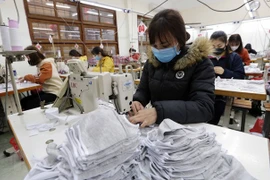Truong Van Cam, Vice Chairman and General Secretary of the VietnamTextile and Apparel Association, said due to the heavy dependence on suppliesfrom China, most of the firms lacked raw materials.
Cam said: “They are now either shifting to import rawmaterials from other countries or using domestic ones.”
However, he said: “The diversification of sources of importedraw materials takes time and is more expensive because of higher import prices,higher shipping and warehousing costs,” adding that: “Using domestic sources isa more feasible solution.”
Than Duc Viet, general director of May 10 garment firm, saidtogether with the largest supplier of China, his firm also used a variety offabric sources from over 600 different suppliers in the world to make theirshirts.
Though Viet felt the burden of loan interest and debtrepayments as well as the risk of order cancellations from customers in such adifficult time, his firm with alternative raw materials can maintain productionin the next few months.
For the longer period, Viet said: "Currently, we areconsidering using the local resources of fabric, but we must negotiate withpartners to postpone or extend delivery time, as well as change the requirementof origin to be able to use those sources.”
Nguyen Van Thoi, Chairman of TNG Investment and Trading JointStock Company, said as the majority of the firm’s orders was the free-on-board(FOB) which their customers prepared raw materials early, “we have sufficientinput for production until the end of the first half of the year and areplanning sources for the third quarter and the whole year now.”
Thoi added: “Compared to last year, our traditional customershave increased their orders in 2020. For example, Decathlon (France) increasestheir orders by 29 percent while Spormaster (Russia) increases by 73 percent.”
After the first two months, TNG achieved a total revenue of 559.5billion VND (23.8 million USD), up 4 percent compared to the same period in2019. In 2020, TNG expects revenue growth of about 10 percent to reach 4.9trillion VND for the whole 2020.
With 70 percent of the materials from local sources, NguyenThanh Tung, director of Ha Tay Chemical Weave Company which produced vulcanisedshoes, sports shoes and injection shoes to export to Europe, Japan and theRepublic of Korea, said: “Most domestic suppliers can meet our productiondemand.”
With a maximum capacity of 120,000 pairs of shoes per month,Tung’s firm still ordered 30 percent of the materials from other countries.Now, he was negotiating with customers to ask them to change those outsidesources to local ones./.





























